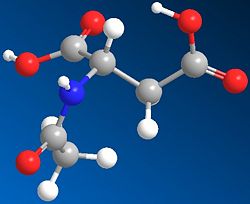N-acetylaspartate
Jump to navigation
Jump to search
N-acetylaspartate (NAA) is the second most concentrated compound in the human brain after glutamate. NAA is synthesized primarily by neurons in the nervous system, however, despite its high concentration, the functions performed by NAA remain uncertain and controversial.
Proposed role for myelin synthesis
NAA is synthesized in neuronal mitochondria by the enzyme N-acetyl-l-aspartate amidohydrolase (aspartoacylase), that is located primarily in the white matter cells. Based on the specific localization of this enzyme (in lipid-rich myelin sheaths) and on the fact that it produces acetyl groups, it has been proposed that the high concentrations of NAA in the brain are to provide a reserve of acetyls for myelin synthesis.[1]
References
- ↑ Chakraborty, G.; Mekala, P.; Yahya, D.; Wu, G.; Ledeen, R.W. (2001), "Intraneuronal N-acetylaspartate supplies acetyl groups for myelin lipid synthesis: Evidence for myelin-associated aspartoacylase", Journal of Neurochemistry 78 (4): 736–745, DOI:10.1046/j.1471-4159.2001.00456.x
